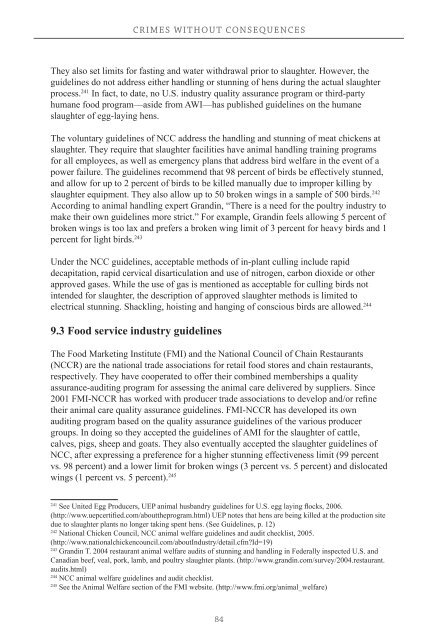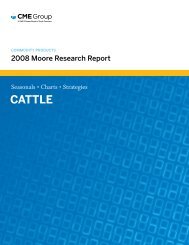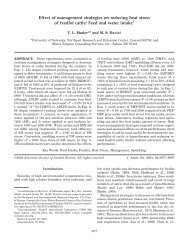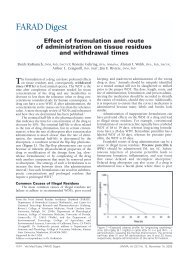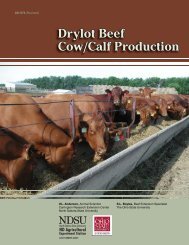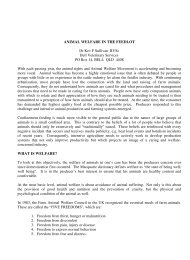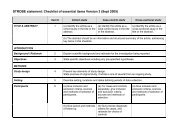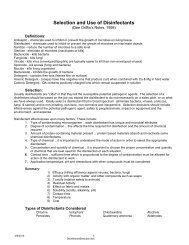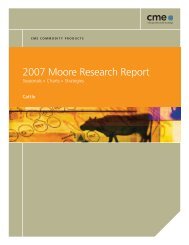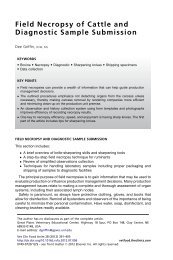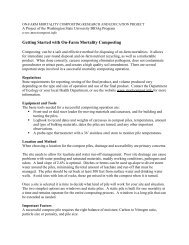CRIMES WITHOUT CONSEQUENCES - gpvec
CRIMES WITHOUT CONSEQUENCES - gpvec
CRIMES WITHOUT CONSEQUENCES - gpvec
Create successful ePaper yourself
Turn your PDF publications into a flip-book with our unique Google optimized e-Paper software.
Crimes Without ConsequenCes<br />
They also set limits for fasting and water withdrawal prior to slaughter. However, the<br />
guidelines do not address either handling or stunning of hens during the actual slaughter<br />
process. 241 In fact, to date, no U.S. industry quality assurance program or third-party<br />
humane food program—aside from AWI—has published guidelines on the humane<br />
slaughter of egg-laying hens.<br />
The voluntary guidelines of NCC address the handling and stunning of meat chickens at<br />
slaughter. They require that slaughter facilities have animal handling training programs<br />
for all employees, as well as emergency plans that address bird welfare in the event of a<br />
power failure. The guidelines recommend that 98 percent of birds be effectively stunned,<br />
and allow for up to 2 percent of birds to be killed manually due to improper killing by<br />
slaughter equipment. They also allow up to 50 broken wings in a sample of 500 birds. 242<br />
According to animal handling expert Grandin, “There is a need for the poultry industry to<br />
make their own guidelines more strict.” For example, Grandin feels allowing 5 percent of<br />
broken wings is too lax and prefers a broken wing limit of 3 percent for heavy birds and 1<br />
percent for light birds. 243<br />
Under the NCC guidelines, acceptable methods of in-plant culling include rapid<br />
decapitation, rapid cervical disarticulation and use of nitrogen, carbon dioxide or other<br />
approved gases. While the use of gas is mentioned as acceptable for culling birds not<br />
intended for slaughter, the description of approved slaughter methods is limited to<br />
electrical stunning. Shackling, hoisting and hanging of conscious birds are allowed. 244<br />
9.3 Food service industry guidelines<br />
The Food Marketing Institute (FMI) and the National Council of Chain Restaurants<br />
(NCCR) are the national trade associations for retail food stores and chain restaurants,<br />
respectively. They have cooperated to offer their combined memberships a quality<br />
assurance-auditing program for assessing the animal care delivered by suppliers. Since<br />
2001 FMI-NCCR has worked with producer trade associations to develop and/or refine<br />
their animal care quality assurance guidelines. FMI-NCCR has developed its own<br />
auditing program based on the quality assurance guidelines of the various producer<br />
groups. In doing so they accepted the guidelines of AMI for the slaughter of cattle,<br />
calves, pigs, sheep and goats. They also eventually accepted the slaughter guidelines of<br />
NCC, after expressing a preference for a higher stunning effectiveness limit (99 percent<br />
vs. 98 percent) and a lower limit for broken wings (3 percent vs. 5 percent) and dislocated<br />
wings (1 percent vs. 5 percent). 245<br />
241 See United Egg Producers, UEP animal husbandry guidelines for U.S. egg laying flocks, 2006.<br />
(http://www.uepcertified.com/abouttheprogram.html) UEP notes that hens are being killed at the production site<br />
due to slaughter plants no longer taking spent hens. (See Guidelines, p. 12)<br />
242 National Chicken Council, NCC animal welfare guidelines and audit checklist, 2005.<br />
(http://www.nationalchickencouncil.com/aboutIndustry/detail.cfm?Id=19)<br />
243 Grandin T. 2004 restaurant animal welfare audits of stunning and handling in Federally inspected U.S. and<br />
Canadian beef, veal, pork, lamb, and poultry slaughter plants. (http://www.grandin.com/survey/2004.restaurant.<br />
audits.html)<br />
244 NCC animal welfare guidelines and audit checklist.<br />
245 See the Animal Welfare section of the FMI website. (http://www.fmi.org/animal_welfare)<br />
84


